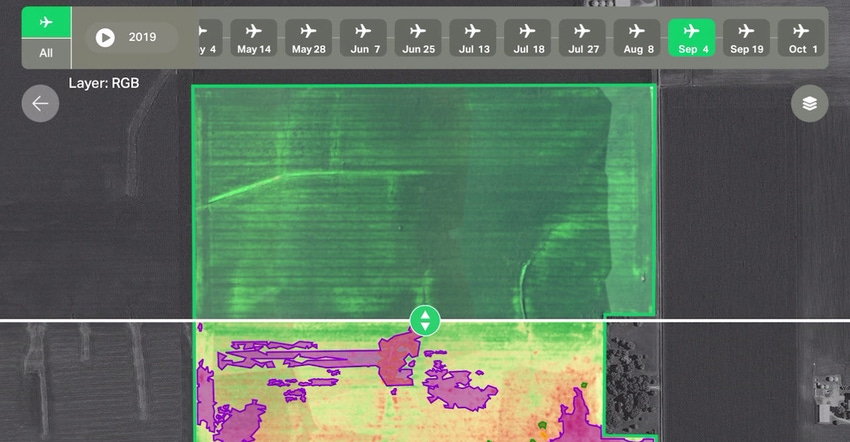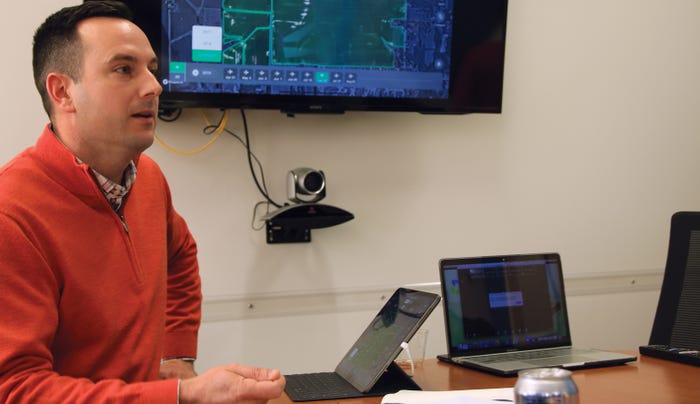
Timesaving scouting technology is improving for farmers, with Champaign, Ill.-based IntelinAir recently updating its AgMRI platform.
It issues automatic alerts for the worst and most addressable problems on fields following the 13 flights the company commissions for its customers throughout the growing season.
Customers of the 4-year-old startup pay about $5 per acre, which covers the iOS, web-based app and flights. The majority of the farmers and companies that use the service are currently concentrated in Illinois and parts of Indiana and Iowa, though the company can take in imagery that meets their standards from partners throughout the world, including drone pilots.
According to IntelinAir CEO Al Eisaian, the company will fly 5 million acres in 2020, up from 1.8 million in 2019.
Darrel Thoma, manager of Dowson Farms, is one of the company’s largest customers. While not all of the acreage under Dowson Farms management falls under IntelinAir’s coverage area, he’s found it valuable on the fields that are covered.
“Even before we started using AgMRI, when we used to go out on our own, we would specifically look for fields where we would see premature death,” Thoma says, noting that with the IntelinAir platform, he doesn’t waste time searching for the dead zones on foot.
“We immediately redirect all of our combines and go out there and start harvesting the fields with premature death or hybrids that showed it. The yield losses in there and spreading out is very significant,” he adds.
IntelinAir concentrates nine of its flights before the crop’s canopy closes, including one bare ground flight at the very beginning. By the third or fourth flight, the crop reaches about 6 inches high. This allows for accurate emergence readings, says Josh Thornsbrough, vice president of sales and marketing and an Alvin, Ill., farmer.
The last four flights help plan harvest, with drydown progress observable thanks to the heat seeker component of AgMRI.
The 10-centimeter resolution plane imagery is precise enough to pinpoint and count rows early on, as well as to notice differences in color in emergent crops. Eisaian says updates made for the 2020 season have improved the accuracy of early emergence detection. IntelinAir algorithms automatically identify 10 different patterns for customers, too, helping them pinpoint things like broken tile drainage lines, plugged knives on the planter and more.
“We recently surveyed 20 of our customers from smallest to the largest. And the average return on the investment was $34 an acre,” Thornsbrough says, noting the return was earned from at least “10 good decision-making opportunities” the IntelinAir platform made customers aware of with time to act.
“Whether it be replanting or nutrient deficiency, we’ve seen all these problems across the entire customer base. So if you didn’t detect that you had a downforce problem on one of your planters or a weed infestation, we will,” he adds.

COORDINATION: IntelinAir’s largest strength lies in being able make coordinating tasks among ag retailers, agronomists and employees easier, says Josh Thornsbrough, vice president of sales and marketing.

Eisaian says the $5 per acre may change as membership grows, but the investment “pays for itself” by giving producers instant information about what’s happening in their field. If prices surge as harvest begins, the app can, for example, help to coordinate harvest of dried-down fields faster.
He hopes IntelinAir will be free for farmers in the near future, offered as a service through seed dealers and insurance providers.
“If you have any type of weather-related damage, this automatically calculates what your damage is, so you can just share that with your insurance adjuster so he doesn’t have to drive hundreds of miles to get to your field,” Eisaian says, noting USDA could offer membership to an IntelinAir-like service to lower the amount of payouts the agency has to give out.
AgMRI also uses continuously updated satellite data to monitor color changes and weather outside of the 13 flights. When users are examining a field with AgMRI, a recent update now allows them to look at the weather history of the field.
Thornsbrough says IntelinAir’s largest strength lies in being able to coordinate tasks among ag retailers, agronomists and employees faster than they could before.
“You can send a crop specialist a scouting request through AgMRI. Then it will pop into their interface. They go scout it, and attach a pin and a picture. And that’s true, streamlined digital collaboration. No more calling up 20 different people,” Thornsbrough concludes.
About the Author(s)
You May Also Like




